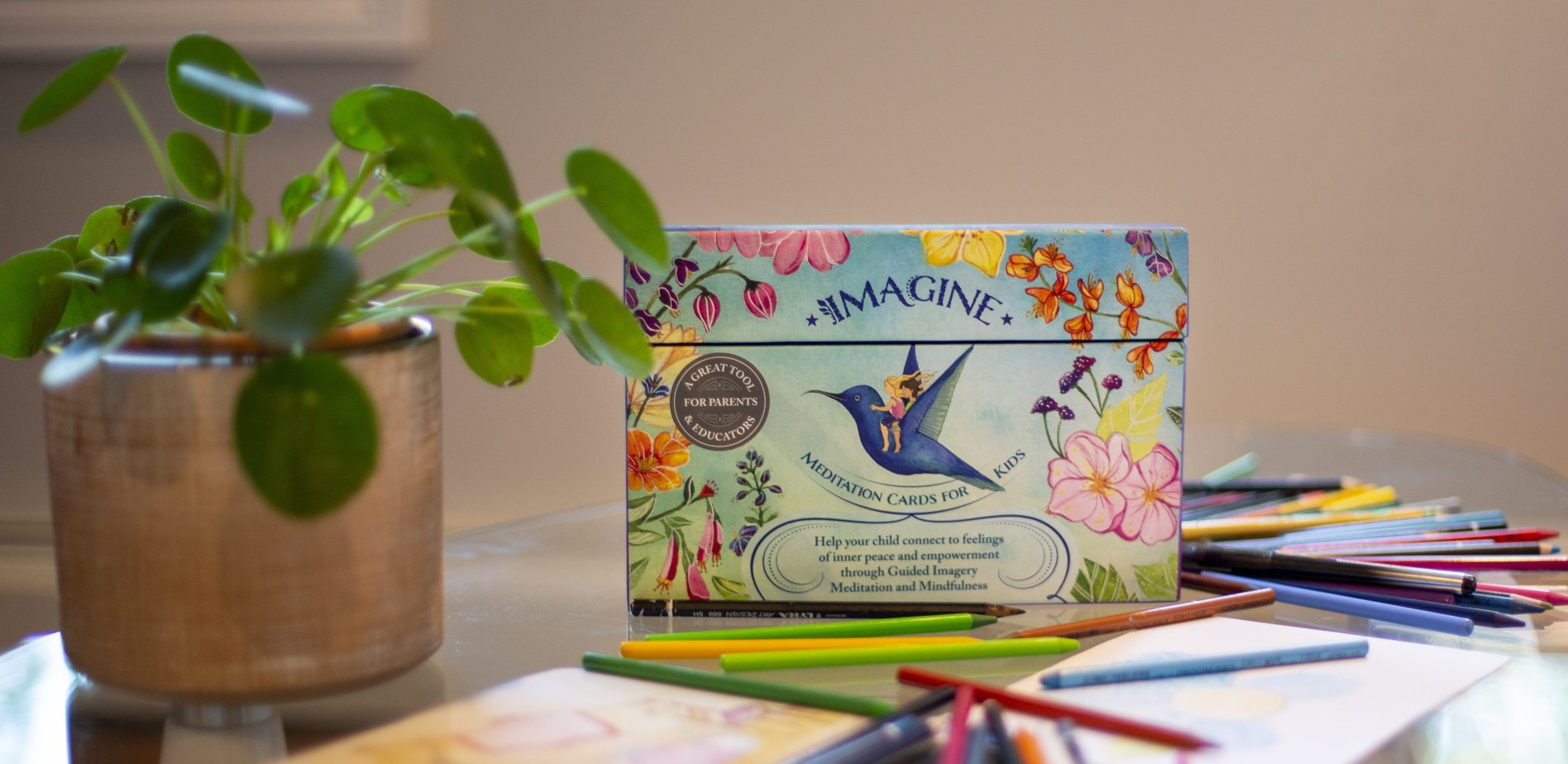A Bird Made of Water: Behind the Scenes of a Kids’ Group Meditation Session
Meirav Tamir • April 22, 2020
On a bright afternoon several months ago, long before the coronavirus unpredictably emerged in the world, I was enjoying a calm meditation session with a group of six young boys.
Okay, let me rephrase that. There were six boys, all fourth graders, and the afternoon was really pleasant but the boys were not at all calm…
They were thrilled to see each other and irrepressibly excited about everything that was opposite of meditation.
Pillows were flying through the air, kids were rolling on carpets, a reflexology ball was doubling as a hot potato. That’s when I turned on some soothing meditation music.
This didn’t much affect their mirth. But it was a first step toward calming down.
When I told the boys what I had planned for our meditation session, they showed a little curiosity, though still seemed unsure if they were in or not. Their multiplayer playdate was still equally (if not more) attractive.
Taking advantage of their uncertainty, I asked them to all begin taking some deep breaths. Okay, finally. At last, I’d made a little progress.
Now was the right moment to begin guiding the meditation.
I began reading my script to the boys
- a meditation script about listening to singing birds on a very early Sunday morning. At first, my voice was a little loud… I mean, more than a little… I had to seize their attention over all the commotion.
After finishing the first sentence, I noticed that the room had become a bit quieter. You’ve got them on the hook. Now reel them in.
By the third sentence, all six boys were laying on the carpet with their eyes closed.
All that could be heard was the sound of my voice reading the meditation script and the music suspended in the distant background.
Such circumstances are something I’ve never really gotten used to. That is, I’m always surprised at how suddenly a very busy room can be hushed.
These all too rare moments of kids laying down with their eyes closed, drawing imaginary pictures in their minds are so precious. And they never last for long… But that is totally fine. We don’t need them to be long.
When we finally reached the end of our meditation, I asked if anyone wanted to share their experience.
Kids are usually eager to share what they’ve imagined and how meditating felt. It’s hard to believe how abundant their minds’ eyes can become in a relatively short length of time.
During our meditation, the boys conjured many visuals, scenes and places, each participant’s imagination expressing their needs or wants at that time.
Every one of them had his very own story to tell.
Some of the boys listened to the script and visualized it, some became very much engaged with their own imaginations and drifted away at a certain point.
But all had lovely stories to share.
So, what did we gain from this session?
- The boys were laying down on the carpet with their eyes closed for a good 10-15 minutes.
- They managed to quiet themselves totally and engage in their personal imaginary worlds.
- During meditation, they were all very calm and focused on the experience.
- They emerged feeling peaceful, uplifted and empowered.
- They enjoyed discussing what they had imagined and felt.
- No screens or any other external distractions were necessary.
“A giant bird made out of water!” shared one of the boys. He said that the birds from the script had merged in his mind with the sounds of water in the music we had on. What a fantastic image!
The Imagine Blog

In my last blog I discussed the everyday challenge of going to sleep and how a simple bedtime routine can be a HUGE help. So now a little more into detail with these great ways to make it work! Phase One – Taking Care of the Body Try dedicating the first 10 minutes of the routine to basic actions that prepare the body for hopping into bed, such as brushing teeth, getting into pjs, and snagging a glass of water. Do your best to make sure these happen at about the same time and, if possible, in the same order. And don’t forget to include a cut-off time for electronics – at least 30 minutes before it’s time to fall asleep. Blue light has been shown to limit production of melatonin, a hormone that’s key to maintaining a healthy sleep cycle. Avoiding electronics right before bedtime will help kids fall asleep faster and wake up feeling rested. Once all of this is out of the way, you can move on to the next phase of the routine. Phase Two – Taking Care of the Heart and Mind The second phase, in my opinion, is the best part of the routine, and it actually offers a priceless opportunity for you to create a 100% nurturing experience for your kids . In fact, the content you pour into the next 10 minutes or so will have a life-long effect on them. There are a ton of different things you can do to treasure your time together. You can… Read a book Take turns saying things you’re grateful for Talk about the good things that happened that day Sing a song or say a prayer Say goodnight to family members, friends, the moon, the stars, the birds, or even the trees outside The Guided Imagery Meditation Option If you haven’t before, you could also give guided imagery meditation a try! You might be surprised how fun and calming it is to visualize a pleasant scene as if you’re part of it. There are many different types of meditation you can do depending on your preference: breathing practice, progressive relaxation, mindfulness meditation focused on the five senses, landscape visualization, self-esteem exercises… And the list goes on! Get started with one of my guided imagery meditation scripts: The Protection Bubble . Then you can branch out based on your success. (Many of my customers swear by bedtime meditation!) Keep it short so bedtime remains as consistent as possible, but don’t be in a hurry. Above all, make sure to be present. These are some of life’s most precious moments, so just relax into the bonding experience. The more you give, the more you’ll receive during these positive, soothing 10 minutes. Oh, and try not to blink… They’ll be all grown-up so fast! :)

“My kids always go to sleep so nice and easy!” said no parent ever. Getting your kids to go to sleep every night can be quite difficult, wouldn’t you agree? When my kids were young, I used to feel like I could fall asleep a hundred times before they ever did. And by the time the house was quiet, I was running on fumes. The Challenge – Encouraging the Kids to Sleep Unfortunately, falling asleep is not something that children can do on command, and it can get frustrating for all parties involved when they struggle with bedtime. The good news is that following a regular bedtime routine can turn that difficulty into willingness and even, dare I say, anticipation. Not only does a solid routine help to bring each day to a close in a positive way, but it also contributes to better sleep at night. This will have a great impact on your children’s health and well-being, not to mention your own... Still skeptical that it’s even possible? Perhaps that’s because you’ve never given guided meditation a try. ;) But before we get into that, let’s talk a little bit about the basics of bedtime. The Road to Success – Creating a 20-minute Bedtime Routine All good bedtime routines are built on a few similar and repetitive activities that occur every night at around the same time. But making the routine predictable does not mean it has to be dull (even though that can help with the process of winding down). The magic lies in creating a familiar and foreseeable space that kids associate with going to sleep. This provides young, active kids with a sense of security that gradually allows them to let go of the day and welcome a good night. Best of all, a bedtime routine doesn’t need to be long! About 20 minutes will do for a soft landing :) In my next blog - an easy two-phase process for a successful and fun bedtime routine.

“ I am smart and capable. I am kind. I am confident. ” Could something so simple actually work? Absolutely, yes! And when it comes to managing thoughts and feelings, it doesn’t get much easier than positive affirmations. What Are Positive Affirmations Positive affirmations are simple, short sentences with motivating or reassuring content that you can repeat to yourself in order to improve your mood or mindset. An easy yet powerful stress management tool, positive affirmations can be applied to any aspect of life to increase your confidence and help you feel good. When used often enough, they can have a real and lasting effect on the way you naturally think and behave. Tips to Maximize Your Affirmations Say the words “I am” in your positive affirmations. Doing so helps to create a more favorable state of mind – one in which you feel connected to the emotions you want to promote. Focus on the present. Sticking to present-tense statements makes them feel more real and attainable. There’s no need to worry about whether the affirmation will come true because you’re telling yourself it already is. Be specific about your wording. Statements that affirm the feelings you want, such as “I am courageous,” are more impactful than statements that negate your current feelings, like “I am not scared.” Using Positive Affirmations With Kids The wonderful thing about positive affirmations is that there is no limit to their usefulness – especially when it comes to kids. Kids encounter so many different situations each day that test their skills and emotions. Here are just a few examples of times when you can try positive affirmations with your child: First thing in the morning, to start each day with a positive mindset At bedtime, to ease their transition to a restful sleep When facing a test at school or any other kind of personal challenge When feeling an overwhelming emotion, such as stress, anger, or sadness What Positive Affirmations Are Not Positive affirmations are a great tool to train the mind toward positive thinking and emotional regulation. But it is worth noting that all emotions are valid and serve a purpose. Kids should know that it is absolutely OK to feel whatever emotion they are feeling. It’s OK to be sad, angry or stressed, and it is OK to feel overwhelmed. Positive affirmations are not a tool to erase negative feelings altogether, since there are times when those emotions are healthy and necessary. This message can be especially helpful to kids, who tend to see things in black and white. That said, positive affirmations are great any time a person decides they’d like to transition to a new mindset. So next time you or your child feel the need to turn things around, give these tips a try. Sometimes, all it takes is a simple “I am OK right now.”
